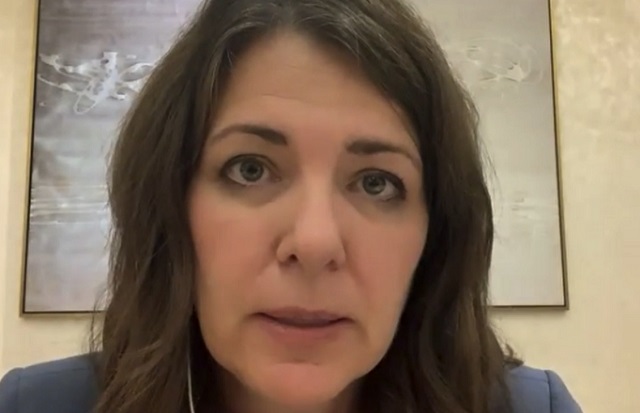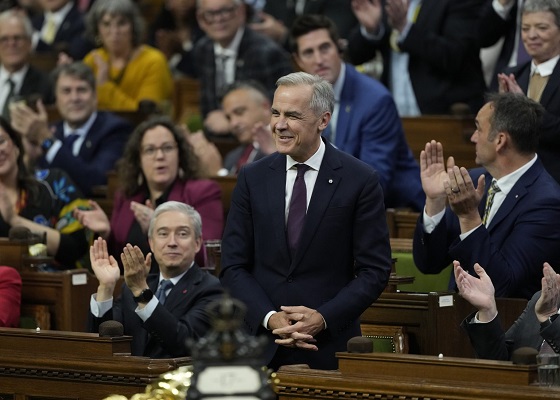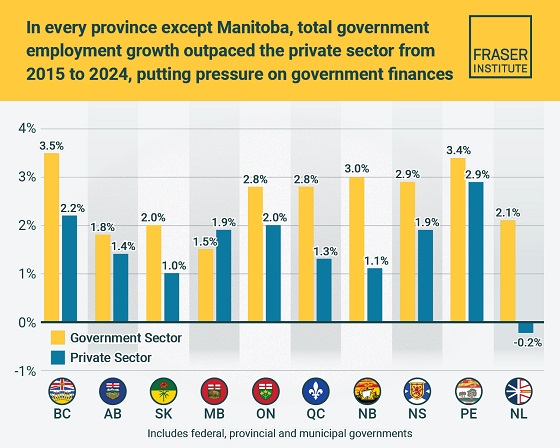Alberta
Danielle Smith: Just ‘watch me’ protect Alberta from federal restrictions on oil, gas production

From LifeSiteNews
‘That is what the Sovereignty Act was about, sending the indication that we’re simply not going to comply with federal rules around this’
Alberta Premier Danielle Smith warned the federal government of Prime Minister Justin Trudeau to “watch me” over how she will shield her province from economic damage and high fuel prices after the feds announced a plan to cut oil and gas production by a third via an “emissions” reduction scheme by 2030.
“You’ll just have to watch me if you don’t believe me. That is what the Sovereignty Act was about, sending the indication that we’re simply not going to comply with federal rules around this,” Smith said while speaking to reporters at the United Nations’ COP28 climate confab on Thursday.
Smith warned that the Trudeau government is risking a full-blown “constitutional crisis” over what she said are “economic sanctions” on Alberta because of Trudeau’s oil and gas production cut.
On Thursday, Environment Minister Steven Guilbeault unveiled a plan at COP28 to slash oil and gas emissions by 35% to 38% below 2019 levels. He claimed that Canada needs to reach “carbon neutrality in Canada by 2050.”
Natural Resources Minister Jonathan Wilkinson claimed that the federal government’s new rules are needed to keep the planet from “burning up.”
Smith agreed to attend COP28 to paint her province in a positive light and to promote its oil and gas industry in direct opposition to the Trudeau feds. She said Alberta and Canada are under attack by the Trudeau government and his “eco-extremist,” admitted socialist environment minister.
Smith issued a joint statement with Alberta Minister of Environment and Protected Areas Minister Rebecca Schulz on Thursday that said the Trudeau government’s new rules amount to a “de facto production cap on Alberta’s oil and gas sector” that is an “an intentional attack by the federal government on the economy of Alberta and the financial well-being of millions of Albertans and Canadians.”
“Alberta owns our resources and under the constitution we have the exclusive jurisdiction to develop and manage them,” Smith said.
“We have done so responsibly by setting a price on carbon as far back as 2007, developing a carbon offset and trading program (TIER), investing billions in commercial scale carbon capture, creating an innovation fund that has so far supported 260 emissions reducing projects with $2.6 billion in grants.”
My joint statement on the Federal government’s proposed emissions cap on Alberta’s oil and gas sector with Minister Environment and Protected Areas Minister Rebecca Schulz:
Today’s announced de facto production cap on Alberta’s oil and gas sector amounts to an intentional attack… pic.twitter.com/mNR69saHkP
— Danielle Smith (@ABDanielleSmith) December 7, 2023
Smith noted that Alberta has its own plan for “reaching carbon neutrality across our entire economy by 2050,” which may or may not come to fruition.
She then took a shot at Guilbeault, calling him an “eco-extremist” whose ideals are “threatening the jobs of hundreds of thousands of Albertans.”
“Ironically, they are also significantly undercutting global emissions reduction efforts by effectively de-incentivizing capital investment by the oil and gas sector in the emissions-reducing technologies and fuels the world needs Alberta to develop and share,” she said.
Earlier this week, Guilbeault announced at COP28 his first attack on the oil and gas sector via a methane emissions cap. Smith blasted his new rules as “unrealistic” and “unconstitutional.”
The Trudeau government is trying to force net-zero regulations on all Canadian provinces, notably on electricity generation, as early as 2035. His government has also refused to extend a carbon tax exemption on heating fuels to all provinces, allowing only Atlantic provinces this benefit.
Trudeau’s current environmental goals are in lockstep with the United Nations’ “2030 Agenda for Sustainable Development” and include phasing out coal-fired power plants, reducing fertilizer usage, and curbing natural gas use over the coming decades.
The reduction and eventual elimination of the use of so-called “fossil fuels” and a transition to unreliable “green” energy has also been pushed by the World Economic Forum (WEF) – the globalist group behind the socialist “Great Reset” agenda – an organization in which Trudeau and some of his cabinet are involved.
Last month, after announcing she had “enough” of Trudeau’s extreme environmental rules, Smith said her province has no choice but to assert control over its electricity grid to combat federal overreach, by enacting its Sovereignty Act.” The Sovereignty Act serves to shield Albertans from future power blackouts due to federal government overreach.
Unlike most provinces in Canada, Alberta’s electricity industry is nearly fully deregulated. However, the government still has the ability to take control of it at a moment’s notice.
Guilbeault’s extreme eco-activist past
Guilbeault is as extreme as they come for an environment minister and his background shows a history of breaking the law via activism. In 1997, he joined Greenpeace and served for a time as a director and then campaign manager of its Quebec chapter for about 10 years.
He was arrested many times for environmental protests, the most famous arrest coming after an incident in 2001 when he climbed Toronto’s CN Tower with British activist Chris Holden. The pair hung a banner saying “Canada and Bush — Climate Killers.”
Greenpeace is a group that advocates for population control in addition to calling for an end to all oil and gas.
His extreme ideals have continued in his role as environment minister. He threatened arrest and jail time for Saskatchewan Premier Scott Moe, who said that on January 1 his province will no longer collect a federally imposed carbon tax on electric heat in addition to natural gas.
Smith has repeatedly defended Alberta from Trudeau’s climate regulations and asserted Alberta’s right to control its power grid, also promising the province will not be “transitioning away” from oil and natural gas. She has called on Trudeau to replace Guilbeault because he is too “extreme.”
Alberta does have support from the Supreme Court, however, which recently sided in favor of provincial autonomy when it comes to natural resources. The Supreme Court ruled that Trudeau’s law, C-69, dubbed the “no-more pipelines” bill, is “mostly unconstitutional.” This was a huge win for Alberta and Saskatchewan, who challenged the law in court. The decision returned authority over the pipelines to provincial governments, meaning oil and gas projects headed up by the provinces should be allowed to proceed without federal intrusion.
The Trudeau government, however, seems insistent on defying the recent rulings by pushing forward with its various regulations.
Alberta
New pipeline from Alberta would benefit all Canadians—despite claims from B.C. premier

From the Fraser Institute
The pending Memorandum of Understanding between the Carney government and the Alberta governments will reportedly support a new oil pipeline from Alberta’s oilsands to British Columbia’s tidewater. But B.C. Premier David Eby continues his increasingly strident—and factually challenged—opposition to the whole idea.
Eby’s arguments against a new pipeline are simply illogical and technically incorrect.
First, he argues that any pipeline would pose unmitigated risks to B.C.’s coastal environment, but this is wrong for several reasons. The history of oil transport off of Canada’s coasts is one of incredible safety, whether of Canadian or foreign origin, long predating federal Bill C-48’s tanker ban. New pipelines and additional transport of oil from (and along) B.C. coastal waters is likely very low environmental risk. In the meantime, a regular stream of oil tankers and large fuel-capacity ships have been cruising up and down the B.C. coast between Alaska and U.S. west coast ports for decades with great safety records.
Next, Eby argues that B.C.’s First Nations people oppose any such pipeline and will torpedo energy projects in B.C. But in reality, based on the history of the recently completed Trans Mountain Expansion (TMX) pipeline, First Nations opposition is quite contingent. The TMX project had signed 43 mutual benefit/participation agreements with Indigenous groups along its route by 2018, 33 of which were in B.C. As of March 2023, the project had signed agreements with 81 out of 129 Indigenous community groups along the route worth $657 million, and the project had resulted in more than $4.8 billion in contracts with Indigenous businesses.
Back in 2019, another proposed energy project garnered serious interest among First Nations groups. The First Nations-proposed Eagle Spirit Energy Corridor, aimed to connect Alberta’s oilpatch to a port in Kitimat, B.C. (and ultimately overseas markets) had the buy-in of 35 First Nations groups along the proposed corridor, with equity-sharing agreements floated with 400 others. Energy Spirit, unfortunately, died in regulatory strangulation in the Trudeau government’s revised environmental assessment process, and with the passage of the B.C. tanker ban.
Premier Eby is perfectly free to opine and oppose the very thought of oil pipelines crossing B.C. But the Supreme Court of Canada has already ruled in a case about the TMX pipeline that B.C. does not have the authority to block infrastructure of national importance such as pipelines.
And it’s unreasonable and corrosive to public policy in Canada for leading government figures to adopt positions on important elements of public policy that are simply false, in blatant contradiction to recorded history and fact. Fact—if the energy industry is allowed to move oil reserves to markets other than the United States, this would be in the economic interest of all Canadians including those in B.C.
It must be repeated. Premier Eby’s objections to another Alberta pipeline are rooted in fallacy, not fact, and should be discounted by the federal government as it plans an agreement that would enable a project of national importance.
Alberta
Premier Danielle Smith says attacks on Alberta’s pro-family laws ‘show we’ve succeeded in a lot of ways’

From LifeSiteNews
Recent legislation to dial back ‘woke progressivism’ is intended to protect the rights of parents and children despite opposition from the left.
Alberta Premier Danielle Smith took a shot at “woke progressivism” and detractors of her recent pro-family laws, noting that because wokeness went “too far,” the “dial” has turned in favor of parental rights and “no one” wants their “kid to transition behind their back.”
“We know that things went a little bit too far with woke progressivism on so many fronts and we’re trying to get back to the center, trying to get them back to the middle,” Smith said in a recent video message posted on the ruling United Conservative Party’s (UCP) official X account.
Smith, who has been battling the leftist opposition New Democratic Party (NDP) attacks on her recent pro-family legislation, noted how “we’ve succeeded in a lot of ways.”
“I think we have moved the dial on protecting children and the right of girls and women to participate in sports without having to face born male athletes,” mentioning that the Olympics just announced gender-confused athletes are not allowed to compete in male or female categories.
“I think we’re moving the dial on parental rights to make sure that they know what’s going on with their kids. No one wants their kid to be transitioned behind their back and not know. I mean, it doesn’t matter what your background is, you want to know what’s going on with your child.”
Smith also highlighted how conservatives have “changed the entire energy conversation in the country, we now have we now have more than 70 percent of Canadians saying they believe we should build pipelines, and that we should be an energy superpower.’
As reported by LifeSiteNews, Smith recently said her government will use a rare constitutional tool, the notwithstanding clause, to ensure three bills passed this year – a ban on transgender surgery for minors, stopping men from competing in women’s sports, and protecting kids from extreme aspects of the LGBT agenda – remain law after legal attacks from extremist activists.
Bill 26 was passed in December 2024, amending the Health Act to “prohibit regulated health professionals from performing sex reassignment surgeries on minors.”
Last year, Smith’s government also passed Bill 27, a law banning schools from hiding a child’s pronoun changes at school that will help protect kids from the extreme aspects of the LGBT agenda.
Bill 27 will also empower the education minister to, in effect, stop the spread of extreme forms of pro-LGBT ideology or anything else allowed to be taught in schools via third parties.
Bill 29, which became law last December, bans gender-confused men from competing in women’s sports, the first legislation of its kind in Canada. The law applies to all school boards, universities, and provincial sports organizations.
Alberta’s notwithstanding clause is like all other provinces’ clauses and was a condition Alberta agreed to before it signed onto the nation’s 1982 constitution.
-

 Alberta2 days ago
Alberta2 days agoRed Deer’s Jason Stephan calls for citizen-led referendum on late-term abortion ban in Alberta
-

 espionage2 days ago
espionage2 days agoSoros family has been working with State Department for 50 years, WikiLeaks shows
-

 Indigenous2 days ago
Indigenous2 days agoIndigenous activist wins landmark court ruling for financial transparency
-

 Aristotle Foundation2 days ago
Aristotle Foundation2 days agoWe’re all “settlers”
-

 Artificial Intelligence18 hours ago
Artificial Intelligence18 hours agoGoogle denies scanning users’ email and attachments with its AI software
-

 Business1 day ago
Business1 day agoIs affirming existing, approved projects truly the best we can do in Canada?
-

 Alberta18 hours ago
Alberta18 hours agoPremier Danielle Smith says attacks on Alberta’s pro-family laws ‘show we’ve succeeded in a lot of ways’
-

 Business1 day ago
Business1 day agoTaxpayers paying wages and benefits for 30% of all jobs created over the last 10 years






